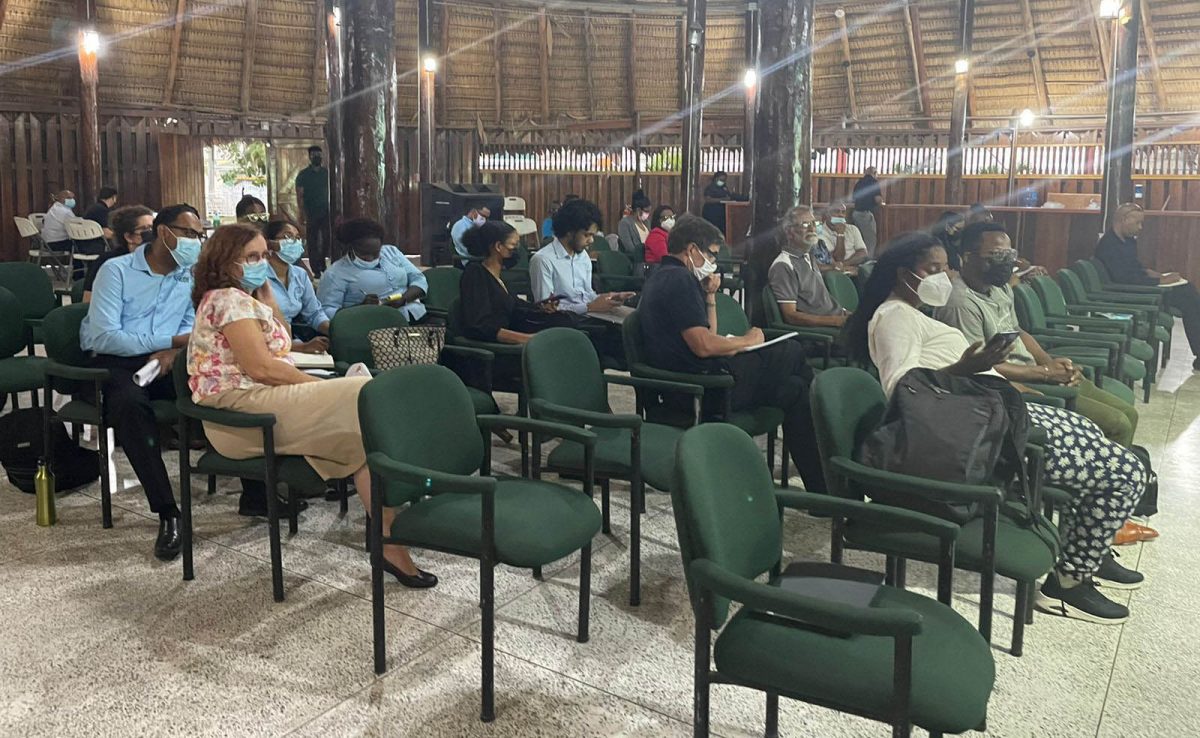Amidst concerns of low fish catches since the commencement of oil operations offshore Guyana, Acorn International on Monday said it is yet to be decided whether any new marine impact studies will be done for the EIA for the fifth planned offshore project – Uaru.
The disclosure was made during a public scoping meeting at the Umana Yana organised by ExxonMobil’s subsidiary, Esso Exploration and Production Guyana Limited (EEPGL) as part of the requirements for the Environmental Impact Survey (EIA).
In relation to the EIA for Yellowtail – the fourth project – a number of environmentalists and activists have railed at ERM, the company which compiled it, for its failure to adequately treat with the environmental impact of offshore activities.
Environmentalists and groups had submitted objections to the EIA contending that the company failed to address a number of impacts on the environment. Also, questions were raised about ERM’s ties to Exxon since it is the same company that did all of Exxon’s EIAs. The environmentalists had also issued calls for the scrapping of the EIA.
Responding to this newspaper’s questions on the plan of action to assess the impact on marine life and whether new studies will be undertaken, Acorn International environmental consultant, Grace Russell said that they will be reviewing the data available before making any decision on undertaking studies.
“So to the extent possible, we would like to use existing data, but if we need to do additional studies, and if those are appropriate given the purpose and scope of the EIA, we will use local consultants versus international consultants [to undertake those studies].”
ExxonMobil’s in-country Project Manager Anthony Jackson echoed similar sentiments stating that they will like to build on existing data from previous EIAs.
He said that in this EIA they will be looking at the cumulative effects of all offshore production facilities.
Since the Yellowtail study, he pointed out that they have been conducting studies on the cumulative effect of the FPSOs on marine and marine mammal life in the area of operations.
“This is, it’s not something that I would say we’re going to be doing new, this is something that we are effectively continuously looking at and updating with the new information we have at any given time,” Jackson responded when he answered the question.
He pointed out that this process will continue with Acorn International conducting assessments of impacts on marine life with their EIA for the Uaru development, since it is a basic part of their business.
Pressed further, Jackson stated that during other consultations across the coast, EEPGL had heard a tremendous amount of concerns from the fishing community. He went on to state that in addressing these concern and ensuring that they are captured in the EIA, they have been working with the Department of Fisheries, the Government of Guyana, and stakeholders, to determine how best they can study the impacts.
Noting that the marine life studies, are “extremely complicated,” Jackson explained the importance of continuing to assess the impacts and understanding the findings of their baseline studies.
“It takes a lot of understanding the baseline studies and then what are the driving factors before we can make conclusions, which is why it’s so important that we continue with the studies. Acorn is committed to doing that, EEPGL is committed to supporting these studies to understand if we have any impact and how to address this,” he asserted.
At one point, Jackson stated that many of the findings from the baseline studies are available in the published EIAs.
However, attorney-at-law, Elizabeth Deane-Hughes, questioned the chances of environmental studies done two years ago being applicable today.
“So what is the cumulative equation that is going to be used in this? Is there an equation that if you’re going to use those old studies that can kind of extrapolate on what happened three years ago? Because stuff is happening all the time?” she questioned.
However, Jackson was unable to provide a clear answer on the question.
Responding to Hughes’ comments that it is an abusive process to the people given the number of days to review and peruse a thousand-page document, Jackson said they work within the process designed by the Government and the EPA.
“EEPGL as an operator does work within the process that’s been designed with the government. That’s the short answer as operator. That is, we are bound to follow the guidance and the process as laid out to us as part of the EIA process,” he stated, while indicating that if the process changes they will commit to providing more time for the review and feedback for the EIA.
The current scoping meetings are being used to develop the Terms of Reference for the EIA for the fifth development.
“In keeping with the Environmental Protection Act, CAP. 20:05, Laws of Guyana, the EPA has determined that an environmental impact assessment (EIA) is required to be conducted before any decision to approve or reject the proposed project is taken, since this development may significantly impact the environment,” ExxonMobil said in notices published in the newspaper.
The final meeting is scheduled for tomorrow at the Leonora Technical Institute, West Coast Demerara, at 3pm.
Interested persons can also submit comments to the EPA via their email epa@epaguayan.org or address comments to: Executive Director, Ganges Street, Sophia, Georgetown.






